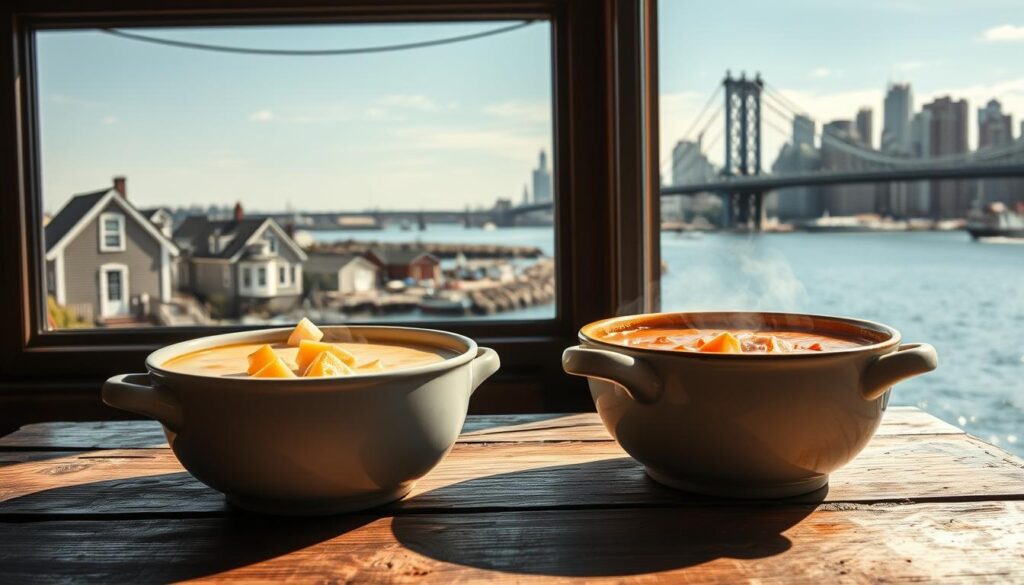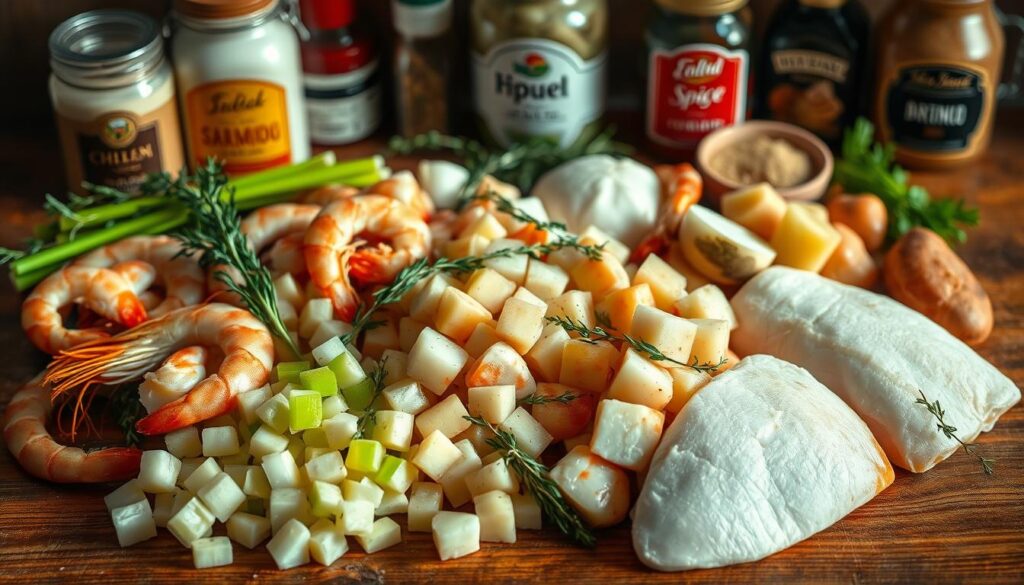My first time trying seafood chowder was on a cold Maine evening. The warm, creamy fish chowder made the night cozy. Since then, I’ve worked hard to make seafood chowder recipes that bring back that feeling.
Seafood chowder is more than soup. It’s a trip through the sea’s flavors, with creamy broths and fresh fish. Whether you’re experienced or new to cooking, these recipes will impress and satisfy you.
A great chowder balances seafood, creamy base, and seasonings. This guide will teach you to make the best creamy chowder at home.
Table of Contents
Understanding the Basics of Seafood Chowder
Seafood chowder is a culinary journey that mixes ocean flavors with hearty ingredients. Whether you love clam chowder or shrimp chowder, knowing the basics will improve your cooking.
To make a perfect seafood stew, you need to know about bases, ingredients, and cooking methods. Let’s explore the key elements for a great seafood chowder.
Types of Seafood Chowder Base
Chowders have many tasty variations, each with its own base:
- Cream-based: Classic New England style, rich and smooth
- Tomato-based: Manhattan-style, with a tangy red broth
- Clear broth: Light and zesty seafood option
Essential Ingredients and Equipment
To make an amazing seafood chowder, you’ll need certain ingredients and tools:
- Fresh seafood (shrimp, clams, cod)
- Potatoes (approximately 1 pound)
- Aromatics (onions, celery)
- Large pot or Dutch oven
- Sharp knife and cutting board
Common Mistakes to Avoid
Master your seafood chowder by avoiding these mistakes:
- Overcooking seafood (becomes tough and rubbery)
- Making the chowder too thick
- Using low-quality or frozen seafood
- Skipping the seasoning
With these tips, you’re set to make a delicious seafood chowder that will wow your family and friends.
Classic New England vs Manhattan Style Chowders

Seafood chowder fans often argue over New England and Manhattan chowders. These two styles have unique tastes that show their roots.
New England chowder is famous for its rich, creamy texture. It’s made with heavy cream, making it rich and indulgent. Fishermen in the Northeast use fresh seafood like clams and crab to make it.
Manhattan chowder, on the other hand, is light and tangy. It’s based on tomatoes, giving it a fresh taste. This style came from New York City’s diverse food scene, offering a zesty twist.
| Characteristic | New England Chowder | Manhattan Chowder |
|---|---|---|
| Base | Cream | Tomato |
| Primary Flavor | Rich and Creamy | Tangy and Light |
| Common Seafood | Clams, Crab | Clams, Mixed Seafood |
When making your own chowder, think about these differences. New England chowder is great for those who want a comforting, rich dish. Manhattan chowder is better for those who like a lighter, more acidic taste.
- New England chowder uses cream for thickness
- Manhattan chowder relies on tomato base
- Both styles showcase regional culinary traditions
Whether you love the creamy New England chowder or the bright Manhattan chowder, both offer a tasty trip through American seafood.
Essential Ingredients for Perfect Seafood Chowder Recipes

Making a great seafood chowder begins with picking the right ingredients. Your stew can go from good to amazing by choosing the best seafood, herbs, and seasonings.
Best Seafood Combinations
For a flavorful fish chowder, mix different seafood types. The best mix usually has:
- Tender cod for a mild, flaky texture
- Sweet sea scallops for richness
- Succulent shrimp for added complexity
- Delicate haddock for more flavor layers
Fresh vs Frozen Seafood Options
Fresh seafood is best for the tastiest chowder. Fresh catches have better texture and taste. But, high-quality frozen seafood is great when fresh is hard to find.
Here’s what to look for in seafood:
- Choose firm, clear flesh without discoloration
- Make sure there’s no strong fish smell
- Buy from trusted seafood markets
Herbs and Seasonings Selection
The right herbs and seasonings make your stew stand out. Classic choices include:
- Fresh thyme for earthy notes
- Bay leaves for a subtle depth
- Old Bay seasoning for a classic sea taste
- Freshly ground black pepper for warmth
By picking the right ingredients and knowing how they work together, you’ll make a seafood chowder that’s both delicious and comforting.
Step-by-Step Cooking Instructions
To make the perfect seafood chowder, start by preparing your ingredients carefully. First, sauté diced onions in unsalted butter until they’re soft and translucent. This takes about 5 minutes. It creates a rich base that will excite your taste buds.
Then, add diced potatoes and seafood stock to simmer. The potatoes take 10-15 minutes to cook just right. For a true shrimp chowder, mix scallops, shrimp, cod, and haddock. Bay scallops are budget-friendly, while sea scallops are sweeter and tenderer.
When adding seafood, timing is key. Most seafood cooks in 8-10 minutes, keeping it tender and tasty. Add whole milk and heavy cream for a creamy texture. If you want it thicker, a light flour roux works well. Your chowder will be ready in about 30 minutes, with the last 5 minutes for the flavors to blend.
To serve, top with oyster crackers, chopped chives, or mild shredded cheese. A tip: This dish is even better the next day. Store it in the fridge for 2-3 days to let the flavors grow.
FAQ
What is the difference between New England and Manhattan seafood chowder?
New England chowder is creamy and white, made with milk or cream. Manhattan chowder is tomato-based and thinner. New England is richer and smoother, while Manhattan is tangier.
What types of seafood work best in a chowder?
The best seafood for chowder includes firm white fish and shellfish like clams and shrimp. Smoked fish adds depth. Mix different types for varied textures and tastes.
Can I use frozen seafood in my chowder?
Yes, frozen seafood works too. But fresh is better. Thaw and pat dry frozen seafood to avoid water diluting flavor. It’s great for cooking thoroughly.
How do I prevent seafood from becoming tough in my chowder?
To keep seafood tender, add it late and cook briefly. Most seafood cooks in 3-5 minutes. Remove heat as soon as it’s cooked to keep it tender.
What are the essential ingredients for a classic seafood chowder?
Essential ingredients are potatoes, onions, celery, seafood stock, cream or milk, butter, and seafood. Thyme and parsley enhance flavor. Bacon or salt pork add depth.
How can I thicken my seafood chowder?
To thicken, use a roux, cream, pureed potatoes, or cornstarch. Start small and add more as needed. This keeps the chowder creamy.
How long can I store leftover seafood chowder?
Store chowder in an airtight container in the fridge for 3-4 days. Reheat gently to keep it creamy. Don’t freeze chowders with cream, as they can separate.
Can I make a dairy-free seafood chowder?
Yes! Use coconut milk, almond milk, or non-dairy cream. Thicken with cornstarch or arrowroot. Focus on flavor with herbs, spices, and seafood stock.


1 thought on “How to Make the Best Seafood Chowder Recipes: Easy and Savory for Any Occasion”